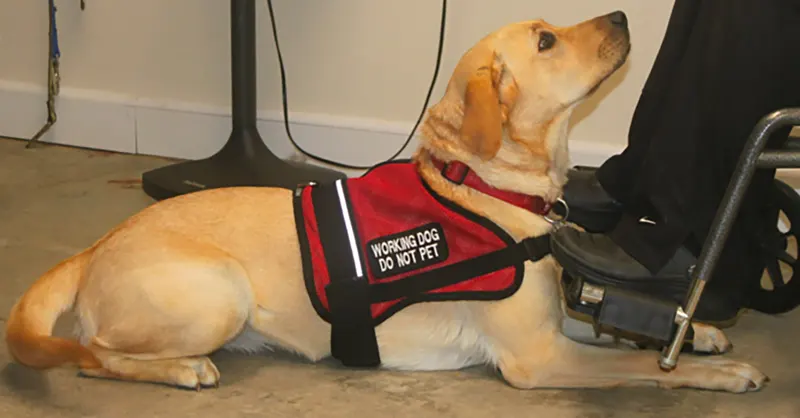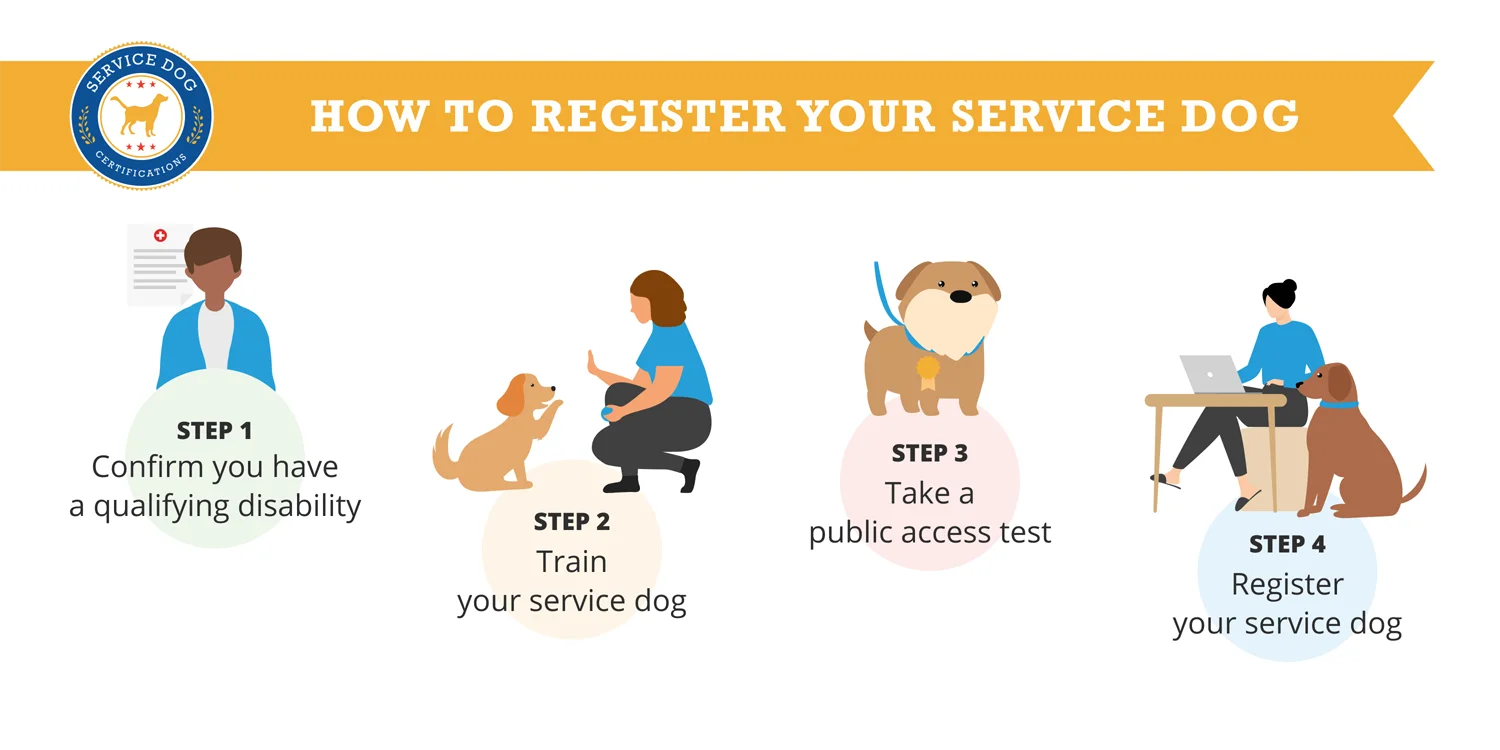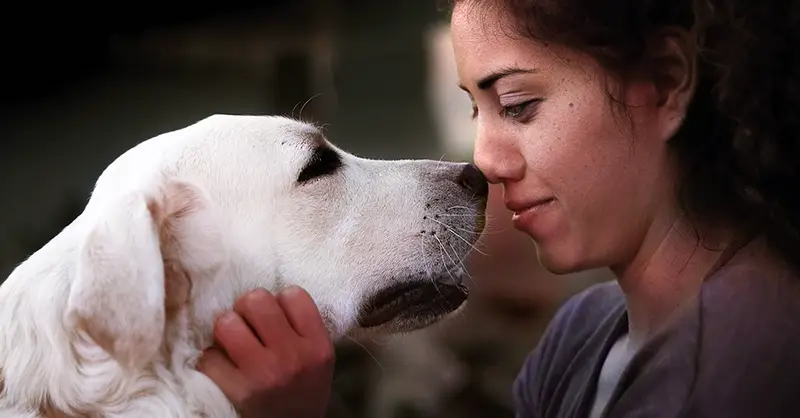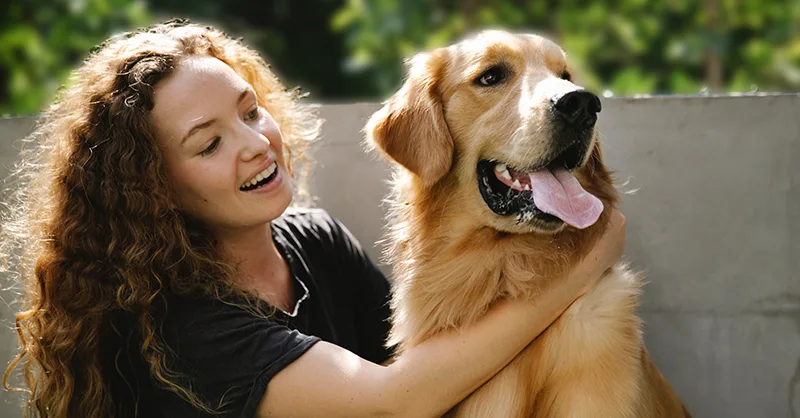Home Page › Blog › Service Dog Requirements
Service Dog Requirements

The ADA defines a Service Animal as a dog individually trained to perform tasks or do work for the benefit of a person with a disability. A disability can be a physical impairment, but the ADA also includes mental illnesses that substantially limit one or more major life activities, such as depression, severe anxiety, or PTSD.
This article will cover the qualification requirements to be a Service Dog handler, what training and tests can be expected for your Service Dog, and what to expect when in public. After covering the legal rights of Service Dogs, we’ll present options for facilitating interactions with the public, including specialized Service Dog accessories and identification.
What are the Service Dog requirements?
Training a dog to become a service animal is available to individuals who have a disability. If you are interested in having a service dog, below are requirements to be aware of:
Eligibility: A person is eligible for a service dog if they have a physical, emotional, or mental health disability
Training: The dog must be trained to take a specific action when needed to assist the person with a disability. The task(s) performed by the dog must be directly related to the person’s disability. The ADA does not require professional training; people with disabilities have a right to train the dog themselves.
Behavior: A service dog must be under its handler’s control at all times.
Verification: If it is not obvious what service the dog provides, the handler must be willing to answer two questions about their service dog. These two questions are: (1) is the dog a service animal required because of a disability? and (2) what work or task has the dog been trained to perform? Staff are not allowed to request any documentation for the dog, require that the dog demonstrate its task, or inquire about the nature of the person’s disability.
Identification: Optionally, it can help service dogs to be clearly identified with accessories like ID cards, vests, tags, and certificates.
How does my dog become a Service Dog?
Consider these four simple steps to help you understand how your dog can become a service dog.
- Determine if you have an eligible disability
- Train your Service Dog
- Pass a Public Access Test
- Consider Service Dog Certification and Registration
Service Dogs serve an important function for those in our community who need special care. It’s crucial for both Service Dog handlers and the general public to be aware of what Service Dog requirements are.
Step 1: Determine if you have an eligible disability
Under the ADA, you must have a qualifying condition to have a Service Dog. The condition can take many forms (physical, mental, etc.). Physical disabilities include conditions like visual impairment, limited mobility, and hearing loss. The physical or mental impairment must substantially limit a major life activity like the ability to work, move about, socialize, or sleep.
Some common conditions that qualify for Psychiatric Service Dogs are anxiety, depression, and PTSD, but this list is not exhaustive. For psychiatric disabilities, a common first step is to be evaluated by a Licensed Mental Healthcare Practitioner (LMHP) who can write a letter confirming your eligibility. These PSD letters typically have the following traits:
- written on the licensed healthcare professional’s letterhead
- dated and signed by the professional
- contain the professional’s contact information, license number, license date, and state of licensure
- contain the professional’s opinion on whether you have a mental or emotional disability that can qualify for a psychiatric service dog
Step 2: Training your Service Dog
To be considered a Service Dog, a dog must be individually trained to perform a job or task relating to your disability. Be aware that there is no official organization that sets training standards in the U.S. You are not required to work with a trainer – the ADA allows handlers to train their dogs on their own.
While there’s no minimum requirement in the US, some private standards suggest approximately 120 hours over six months. Some sources recommend that at least 30 hours (about ¼ of the time) be spent in public to help train the dog for moments of distraction and when surprises come their way. While not required, it can be helpful for Service Dogs to wear relevant accessories so that people in public can adjust their behavior accordingly.
The most important thing for you to teach your Service Dog is tasking or learning the specific skill they will be performing to help assist with your disability. There are countless tasks Service Dogs are called on to perform, including guiding the visually impaired, pulling a wheelchair, sensing a medical alert, tactile stimulation during a panic attack, reminding the handler to take their medication, scouting a room for someone with PTSD, or grounding/blocking in public areas.
Step 3: Pass a public access test
In addition to training your dog to perform tasks that assist with your disability, it is important for a service dog to be able to comport itself appropriately in public by passing a public access test.
Public Access Criteria:
- No aggressive behavior towards people and other animals.
- Refrain from sniffing behaviors unless released to do so.
- No solicitations for food or affection while on duty.
- No over-excitement and hyperactivity in public.
- Able to tolerate novel sights and sounds in various public settings.
- No unruly behavior or excessive barking.
- No relieving themselves in public without being given a specific command.
Once your dog is properly trained, your next step is to decide how you prefer to identify your service dog.
Step 4: Service Dog Certification and Registration
In the United States, service dog certifications and service dog identifications are not legally required. Staff at a public establishment cannot solicit documentation, such as proof that the animal has been certified, trained, or licensed as a Service Dog, as a condition for entry.
Despite the limited verification requirements established by the law, staff at many public establishments will still insist on IDs or other tangible proof of Service Dog status. Service Dog handlers often find it helpful to have documents and accessories that help signal that their dog is trained and at work in order to prevent being met with hostility and confusion.
Electing to carry a custom Service Dog ID card and Service Dog Vest may be helpful tools for you and your service dog to navigate public spaces. You may also choose not to carry the ID card and stand your ground on principle when you encounter people ignorant of service dog rights. Under ADA rules, staff at a venue may only ask two questions if the handler’s disability is not apparent: (1) is the dog a service animal required because of a disability? and (2) what work or task has the dog been trained to perform?

After you verbally confirm that your dog is a trained service dog, reasonable accommodations must legally be made for service dogs. Service Dogs can go anywhere their handlers can go, provided they do not pose a health or safety hazard to others. If a particular service animal behaves in a way that poses a direct threat to the health or safety of others, has a history of such behavior, or is not under the control of the handler, that animal may be excluded. If an animal is excluded for such reasons, staff must still offer their goods or services to the person without the animal present. It’s important to understand these rules so you know what rights you have as the owner of a Service Dog and when third parties are violating your rights.
You’re all caught up on what it takes to have a Service Dog!
Ready to register and ID your dog?
Unable to train your dog as a service dog?
You may be interested in an Emotional Support Animal instead. ESAs do not require specific training, have access to no-pet apartments, and are exempt from breed or weight restrictions. Click here to learn more about ESAs.
In short, ESAs are protected under Federal Housing Regulations (but not the ADA), meaning that you cannot be charged any pet rent, deposits, or fees, nor can you or your ESA be denied housing on the grounds of living with a pet, with very few exceptions.
To qualify for an ESA, you must have a licensed mental health practitioner (including, but not limited to, psychologists, therapists, social workers, GPs/PCPs, etc.) write a letter affirming that you have a qualifying condition (including, but not limited to, depression, anxiety, PTSD, etc.) that is helped by an emotional support animal. Additionally, unlike Service Animals, ESAs do not necessarily have to be dogs; cats, rabbits, and birds are other common choices.
¿Quieres leer este artículo en español?
Puede encontrar una versión traducida al español de los requisitos para perros de servicio aquí.
Want to read this article in Spanish?
You can find a Spanish translated version of Service Dog Requirements here.
About the Author: The writing team at Service Dog Certifications is made up of folks who really know their stuff when it comes to disability laws and assistance animals. Many of our writers and editors have service dogs themselves and share insights from their own experiences. All of us have a passion for disability rights and animals.
439 comments
Leave a Reply Cancel reply
Latest Posts

How to Bring a Service Dog to Disneyland
Trained service dogs are more than welcome to join their handlers at Disneyland. In this guide, we’ll explain Disneyland’s policies and give practical advice for bringing a service dog to Disneyland for the first time. Disneyland’s Service Dog Policies The Magic Kingdom is happy to welcome trained service dogs across most park locations! They kindly […]

Read More

Can Dogs Eat Tomatoes?
Yes! Dogs can safely enjoy tomatoes, but there are a few risks to be aware of so you can feed your dog responsibly. Fully ripe tomatoes (without the stems and leaves) can actually have nutrients that are good for your pup. Tomatoes have chlorogenic acid, an antioxidant that can have anti-inflammatory effects in cells. They’re […]

Read More

Can a Primary Care Doctor Write an ESA Letter?
Your family doctor, also called a primary care physician (PCP), can write a letter recommending an emotional support animal. We’ll explain what legally gives them that ability and explore what better options might be available for you. Why are Physicians Able to Write an ESA Letter? To turn your pet into an emotional support animal, […]

Read More







Quick question, going through a heated divorce. The dog is registered under my name, I have taken him to all his veterinarian appointments, and the microchip and rabies are also under my name. My husband has falsified that she is a service dog because he wants to keep her. She performs no service for him and he has no disability but he does have a paper that says he is his service dog. Please advise.
Hello my name is Tim Price I have multiple sclerosis and PS TD on all the damn word but I have a dog I can’t 14 Ford and put him through training he’s just a pub a year and a half old I can forward to feed me and him dearly and pay rent when I need him he goes everywhere I go but they won’t let him in a lot of places and so I just can’t go there please help your friend
Falsified your dog as a “Emotional Support Animal” or a true and trained Service animal.. this is a big difference. “emotional support animal docs can be paid for online without any training needed. The dog does not provide anything but comfort.. an actual Service animal has papers and license.. very different and I’m sure seen differently in a court of law.
I have trained my dog myself. He has flown thousand of miles with me. He is exemplary in the airport, grocery stores and restaurants. As I have lost my hearing And he has learned to alert me to knocks at the door, the refrigerator alarm going off a and more on his own. . I have paperwork each time I fly that he is an emotional support dog. Due to anxiety. The fact he helps me navigate noises is huge. When I take out my hearing aids I am profoundly deaf. Can. You guide me to making him a full service dog?
As of Dec. 2020 all emotional support animals are band from flying on all US airlines.
Not quite true, this statement. From January 11, 2021, airlines are no longer required to accept ESAs and would handle your ESA as a normal pet. However, it’s also up to the airline to make their own guidelines. So, fingers crossed, some airlines might still recognize the importance of ESAs. But we’ll just have to wait and see in January. Anyway, I found an interesting post about the new DOT rules on this page https://esadoctors.com/new-dot-rules-for-emotional-support-animals/
I just was notified that as of January 11 2021 ESA won’t be able to fly. I have trained my English Bull dog and she is so well behaved. So far Alaska and Delta will not accept them. I think it’s unfair because some people don’t follow procedures so we all lose out. The worst for me is the breed of dog I have they won’t let fly in cargo. Very. Frustrating
Is there a book or anything to teach me how to train the dog. My dog had to be registered to stay in my apartment but I want to take her everywhere. I can’t with a ESA dog. However she knows my seizures. I have had her 10 years and she has been around since they started, since y brain surgery and knows them. What is the process for in stating her training myself or with anyone else to move forward from ESA to service dog?
Samantha
Please reread the article you are commenting on before you give advice. ESAs need a letter by the person’s therapist. Service dogs look and act as a service dog, don’t have any paperwork to show, but must perform a service and wear the proper ensign that show they are working. There are other thinvs, but honestly reread the article, it answers all the questions.
Concerned about a man in NW OKC – man repeatedly lets/encourages his dog wearing a service dog harness to chase cats while out for his walk. Repeated attempts to stop have led to verbal swear word reply from this man with his dog wearing a service dog harness.
I have a picture of the man/dog and vicinity of occurrence
I’d get a fog horn and give it a little blast every time you see him getting ready to let the dog chase
Debbie,
Possibly the man may have a disability that the service dog is providing you may not be able to tell.
You too may read https://www.servicedogcertifications.org/service-dog-requirements/
It will answer your questions. Maybe you could go to the man and ask if he might need assistance.
Smile and be kind to one another.
For the best dog training facility in Albany Call All Dawgs Training. All Dawgs offers obiedence, agility training, and Dog Boarding.
I have Anxiety, Depression, ADHD, & Asthma. Can I quality for a service animal?
Your mentioned disabilities can qualify to get a service dog. You will however need to know how your dog can be of assistance. To have a legitimate service dog your dog needs to be trained to perform a specific task directly helping you with your disability – any task which you could not perform yourself in times of need.
If your dog is mainly providing support and comfort, or you cannot train your dog to perform tasks, then you may consider applying for an emotional support animal letter.
You may find this article with information on how to qualify for a service dog or an emotional support animal interesting https://www.servicedogcertifications.org/do-i-qualify-for-a-service-dog-or-an-esa/
So I was told that my dog has to be trained by a professional for him to be my service dog. I have PTSD, Depression and anxiety. Hes does all the required tasks I need but he is fearful of a few things. I’m still working with him. And I have everything I need. Do I still have to have him professionally trained or can I still have him as my service dog.
You can train your service dog by yourself. In fact, training your service dog may actually deepen the bond between the two of you. However, if you’re having trouble training your dog in certain areas, do seek professional help or guidance to make sure your dog can perform at his best in all public situations. Remember you will be taking him into areas where other dogs are not allowed or settings of high stress. You will want to be sure your dog can stay under control and focus on your needs. You may find this article on if you can train your own service dog interesting: https://www.servicedogcertifications.org/can-i-train-my-own-service-dog/